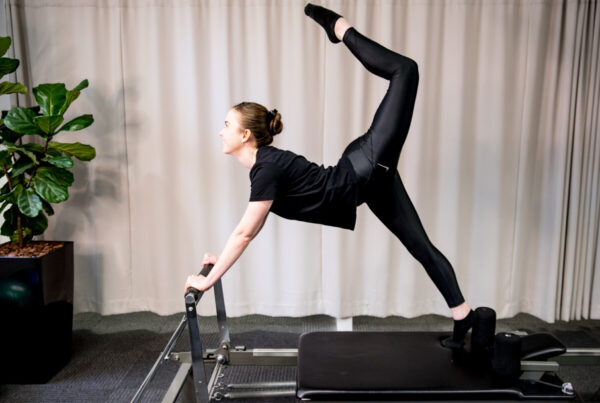There is well documented evidence that exercise is not only safe during pregnancy, but also beneficial. The body undergoes significant changes during pregnancy, often leading to musculoskeletal discomfort and pelvic floor challenges in expectant mothers. Clinical pilates is one way to address these complaints, however as pregnancy advances, pilates must be modified to ensure safety and effectiveness of the program. This blog will detail the common pilates modifications made during pregnancy.
- Avoid Supine Positions: After 20 weeks of pregnancy, it’s recommended to avoid exercises that require lying on the back (ie supine position) for extended periods. This modification helps maintain adequate blood flow to the baby and reduces discomfort, with alternative positions like side-lying, standing, four-point kneeling, and seated used instead.
- Avoid Head Lifts & Crunch Movements. Head lifts and crunches (ie sit up exercises) can put excessive strain on the abdominal muscles which may contribute or exacerbate diastasis recti, often referred to as abdominal separation. During pregnancy, the abdominal muscles will naturally stretch to accommodate the growing of the uterus, however exercises such as head lifts and crunches can worsen this separation. As a safer alternative during the later stages of pregnancy, abdominal exercises that do not involve a crunch position and provide a different challenge to the abdominal muscles are recommended to ensure safety.
- Strength and Mobility Focus: During pregnancy, the body will release the hormone relaxin which leads to an increase in joint laxity in preparation for the birth. As a result, joints become less supported which can cause discomfort. Common complaints include low back, pelvic, hip, and thoracic pain. To address these issues, pilates will focus on exercises that both activate and strengthen the surrounding muscles of these joints, effectively providing increased support and control. Additionally, incorporating mobility exercises can alleviate musculoskeletal discomfort stemming from the body’s transformations during pregnancy.
- Pelvic Floor Focus: In pregnancy pilates, there is a significant emphasis on pelvic floor exercises. These help improve the strength and function of the pelvic floor muscles, which is essential during pregnancy and for postpartum recovery.
- Avoiding Single Leg Exercises: For women experiencing sacroiliac joint pain or pelvic girdle pain, exercises that involve standing on one leg or shifting body weight from one side to the other may need to be avoided to minimise discomfort. Modifications should ensure even weight bearing across both legs to ensure the exercises are comfortable.
- Modified Intensity: The intensity of pilates should be adjusted based on the woman’s activity levels before pregnancy and how she feels during her pregnancy. Generally, as the pregnancy progresses, the intensity of pilates should be reduced to ensure safety and comfort. This is individual for each women and is assessed on a case-by-case basis.
If you are planning to conceive, pregnant or postnatal and are interested in clinical pilates, or just some advice around exercise, get in touch with one of our Women’s Health Physios at Bend + Mend for some guidance.





